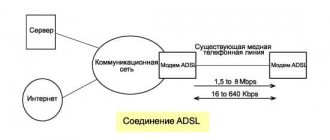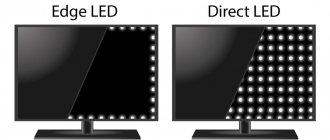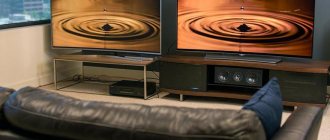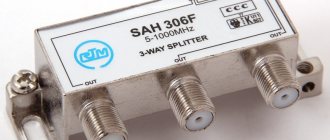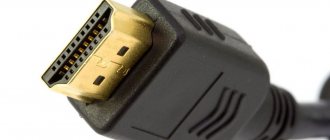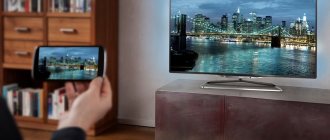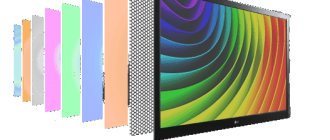The types of modern televisions and their typical classification according to certain characteristics are quite diverse. Therefore, when deciding to purchase new television equipment, many consumers are faced with difficult choices. After all, this is a complex device that is purchased for a long time, so it must have a high degree of reliability. When choosing this type of device, you want it to have an up-to-date set of necessary functions and high technical equipment in a few years. In order to choose the right model for yourself with the necessary parameters and optimal functionality, it is important to understand how the types of TVs differ from each other.
Technologies for creating images on TV
This group of televisions is divided into five types:
- kinescope;
- projection;
- plasma;
- liquid crystal;
- thin OLED.
The first three types are outdated today and are practically not found on sale, so we will not consider them.
LCD TVs
This is the most popular group among consumers. The operation of liquid crystal devices is based on the polarization of the light flux. The source of light here, unlike plasma TVs, is ordinary fluorescent lamps, or, as in LED models, light-emitting diodes. They illuminate the white sheet of the reflective screen behind the glass plate. Liquid crystals are applied to it, which form a picture under the influence of electric current.
Representatives of this group are characterized by economical energy consumption and low weight; they can be easily mounted on a wall using a bracket. In addition, LCD equipment is repairable, which characterizes them as practical devices.
The disadvantages of budget models include a delay in dynamic frames and a limited viewing angle.
The most popular LCD TVs among consumers are LED. LEDs act as illumination for the matrix. The strengths of LED screens include:
- wide range of models and choice of manufacturers;
- any diagonal solutions available today;
- absence of visible flicker and beam focusing defects;
- there are no problems with image geometry and clarity;
- They are perfect for broadcasting not only analogue channels, but also modern digital television.
OLED TVs
It is based on a matrix with organic light-emitting diodes. The picture is displayed on the screen using self-emitting diodes - no backlight is required, as in LCD technology - this is the main difference between OLED and LED. Multi-colored semiconductor devices act as independent light sources. OLED technology makes it possible to create the thinnest screens to date (several millimeters), including curved ones.
Such devices are many times superior to their predecessors. Organic LEDs allow you to obtain the highest possible level of image brightness, contrast, and color rendition. A virtually unlimited viewing angle, which is in no way inferior to plasma technology. In addition, they are much lighter, thinner and more energy efficient than plasma devices. In LCD models, OLED technology benefits from the smooth transmission of dynamic scenes and the absence of constant backlighting.
At the moment, OLED devices have a short service life of about 10 thousand hours, while LCD devices have a stated lifespan of about 60 thousand. And this despite the fact that the cost of such devices is still quite high for the average buyer.
It is worth noting that there is another type of screen promoted by Samsung - QLED. This technology involves the use of LEDs based on quantum dots. Such TVs allow you to transmit colors that are closest to reality.
What is the resolution?
The above classification of TVs took into account their operating principle, but it is more important to choose a TV by resolution. The fact is that mainly LED and OLED TVs are sold on the modern market; other types are quite difficult to find. But screen resolution is a more important topic; it largely depends on the screen diagonal.
- SD (640*480) is found only in old CRT TVs; it is unrealistic to find a TV with such low image quality on sale.
- HD (1280*720) is used in TVs up to 32 inches (inclusive).
- FHD (1920*1080) is used in diagonals from 24 to 50 inches. It is worth noting that buying a 43-inch TV with FHD resolution is not advisable.
- UHD or 4K (3840*2160) is the highest image quality on TVs available to ordinary users. The minimum diagonal is 40 inches.
- 8K (7680x4320) is used on screens from 75 inches. The first TVs with such a high image were presented at CES in 2019. The price of such TVs starts from 700 thousand rubles; they have not yet gone on general sale.
It is worth noting that when choosing a resolution, you need to take into account the screen size and the type of content you plan to watch. So, at 32 inches, FHD can be considered an excessive resolution; it will not make the picture worse, but there will not be any serious differences from HD, but you will have to pay more. If we are talking about matrices 43 inches and higher, which have FHD resolution, then the picture will disintegrate into visible pixels, and there will be little pleasure from viewing.
Backlight options for LCD (LED) screens
The operating principle of the LCD matrix is based on its visual appearance when illuminated. Without backlighting, the crystals are not visible to the user. The quality of the backlight determines the quality of the image that the user sees: its brightness and color rendition.
The most popular solution for illuminating matrices is EDGE LED lighting, which is located around the perimeter. LEDs emit light that is reflected from the diffuser and spreads over the entire surface of the matrix. This kind of backlight does not “work out” black color well, and this is its main problem.
Edge LED and Direct LED technologies
Carpet lighting (Direct LED) occupies the entire area behind the matrix, illuminating it evenly. Through electronic control, local dimming of the matrix is possible when part of the backlight is turned off, resulting in increased contrast.
Types of television matrices
The quality of the picture on a TV screen is determined by the type of matrix on which it operates. All matrices implement different physical principles of operation.
TN+film
This type of matrix is inexpensive and is used in technology in the lower price segment. Given the poor quality characteristics, the matrix is installed in small TVs.
Recognizing this type of crystal is not difficult: TVs with this technology have a minimal viewing angle.
You can see a decent picture only by standing in front of the screen. Changing the viewing angle leads to a significant deterioration in image quality: color is distorted and contrast is reduced.
IPS
This is the favorite matrix of such manufacturers as LG and Philips. It reproduces images with excellent color reproduction. The viewing angle of such a matrix is large. Its weak point is the response time: it is slightly longer than other types, and the high black level.
In the store, this type of matrix can also be recognized visually: at a wide viewing angle, black looks like purple, this is a characteristic feature of IPS.
Difference between TN and IPS matrices
V.A.
This matrix is used by Samsung and other leading manufacturers producing modern TVs. This type of matrix has slightly weaker color rendering and halftone reproduction than IPS screens. However, a matrix of this type has a number of advantages over IPS, namely, it has a better viewing angle, brightness and contrast characteristics are also superior to IPS.
The VA matrix also has its own characteristics, by which it can be identified with the naked eye. When viewing such a TV from the side, the contrast of the image decreases, but the color rendition as a whole does not suffer; a lilac-gray haze is visible on the black pixels.
VA and IPS matrices
UVA
This type of matrix was developed and patented by Sharp specialists. The pixels of this matrix are well illuminated on the back wall (without light leakage), thanks to which the screen produces rich, deep blacks.
The contrast of such a screen is very high, the brightness also gives odds to all other matrices. At the same time, a TV based on such a matrix is energy efficient and consumes very little energy.
Advice! When buying a TV, you should pay attention to IPS, VA and UVA matrices, because... they have the best indicators of efficiency and quality.
Diagonal selection
If you look at the characteristics of TVs, it is easy to notice that, with equal indicators, prices vary greatly. So, a device with a diagonal of 49-50 inches can be bought for 20 thousand rubles, which is extremely cheap. Is it worth chasing big screens because of their availability? Experts say that this approach is fundamentally wrong. You need to choose the diagonal of the TV based on the size of the room. According to the rules, 2.5-3 diagonals should fit from the display to the eyes. If the content is not of very high quality, then the size should be reduced a little, for example, take a margin of 3.5 diagonals.
Advice! It is worth measuring in advance the free space where the device will be placed - if it is a niche or a special designated place in furniture, then a large diagonal may simply not fit into it.
Screen resolution
Experts divide TVs according to screen resolution into three large groups:
- SD;
- HD;
- Ultra HD.
For older CRT TVs, only standard definition television is available - SD. Since most TV channels are still broadcast in this mode, models with a resolution of 720x576 pixels and 720x480 pixels are relevant and used by a large number of users.
For such a TV, you can access premium channels in high quality using a smart card. It is issued by the provider for connection either directly to the TV, through a CAM module, or through a set-top box.
New generation TVs - LED, OLED and plasma - support high-definition and ultra-high-definition television. The most current format is HDTV (from 1280x720 pixels to 1920x1080 pixels). It is available on digital television.
For some OLED device models, the best 4K resolution available today (3840x2160 pixels); 8K (7680x4320 pixels) - Ultra HD.
It is worth noting that the future belongs to UHD TV. But currently only some TV channels broadcast in this format. Cable operators and satellite service providers are constantly expanding the list of channels transmitted in high definition.
Sound quality
It was mentioned above that TVs with good sound are very rare. Basically, this is an expensive segment and devices from 49 inches, where, due to the size of the case, you can install more powerful speakers and even a subwoofer. It's worth noting that the problem with sound most likely comes down to low volume, although sometimes you come across disgusting speakers in general. There is no point in looking at the number of speakers and their power, but when purchasing, it is recommended to check the sound at a volume above average and make sure that there is no extraneous noise.
Smart TV
The concept of “smart” has already touched many areas of technology. The use of “smart” technologies significantly expands the basic capabilities of televisions, making them intuitively controllable and adaptive. Smart TVs don’t just broadcast pictures, they become an entertainment center: they work with any media content, including various applications, and connect to the Internet.
Smart TV Samsung
Smart TVs are no longer a new thing. If the first copies were available (primarily due to price) to a few, now purchasing such equipment is not a problem for a wide range of buyers.
Expansion of functionality to the “smart” level is possible thanks to a built-in computer with a specific operating system and connection to the World Wide Web. The user can go online, use application applications, online cinemas and other useful things.
The most popular smart TV options:
- surfing and access to social networks;
- online cinema opportunities;
- ability to connect to gaming applications.
SmartTVs are similar in functionality to other electronic gadgets (phones and tablets) with Internet access. On them you can use the capabilities of the Internet to search for information, communicate, and play online games.
To enjoy all these benefits, you can access the network through browsers, which is not very convenient or fast. It is more efficient to register as a client on various services: online cinemas, video hosting sites (for example, on YouTube).
Connecting to the network is possible in two ways: cable and wireless Wi-Fi connection. You can control this miracle of technology with a remote control, but it is better to connect a mouse or keyboard to it.
Availability of tuners
The signal source can be an over-the-air antenna, satellite dish or Internet television. Each type requires signal conversion, which is possible in two ways - through an external receiver or using the built-in tuner. The second option is obviously more convenient, since there is no need to clutter up the space with additional equipment, and you don’t need to buy it, which means saving money.
Advice! It is better to choose a TV with DVB-T2/C2/S2 tuners. This will free you from the need to buy external tuners in the future.
Curved TVs
This innovative format has a number of advantages over the traditional TV version:
- the surface of the screen covered by the gaze increases;
- less influence of ambient lighting: no reflections, optical defects, glare;
- the effect of presence is created;
- improvement of viewing angle, contrast.
Such TVs look stylish, unusual, and create the effect of immersion in what is happening on the screen. However, maximum quality is available only to those who sit opposite the center of the arc. For someone sitting on the side, the line of sight will be at a certain angle from the surface of the TV. As a result, the picture will lose brightness, contrast, and color.
Therefore, in order to fully appreciate this format, it is necessary to sit opposite the central axis of the screen and not far from it, so that the TV seems to embrace the user on the sides.
Useful options
Many TVs have additional features, some of which are completely unnecessary, while others will be useful. Useful options include the following.
- Functional media player. The more formats it reads, the easier it will be to watch content from a flash drive.
- HDR, DolbyVision – technologies in UHD TV to improve the picture.
- Game Mode. The TV automatically sets the settings that are most suitable for games via consoles.
- TimeShift – the ability to pause the broadcast and continue watching from the same place.
- Miracast, WiDi, DLNA. Thanks to these options, you can wirelessly stream content to your TV screen from mobile devices or PCs.
- PVR allows you to record broadcasts onto USB media.
- DolbyAtmos is a technology through which audio signal conversion occurs without any loss.
- Voice control on smart TV allows you not to enter requests by text, but simply speak into the microphone on the remote control.
Important! Useless options include 3D and a curved screen.
